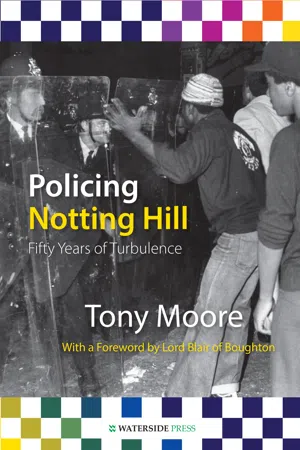
- English
- ePUB (mobile friendly)
- Available on iOS & Android
About this book
Notting Hill is one of the most sought after locations in London. But its progress from 'ghetto' to gentrification spans half-a-century within which it was one of the most turbulent places in Britain—plagued by decline, disadvantage, unsolved killings, riots, illegal drugs, underground bars (or 'shebeens'), prostitution, 'no-go areas' and racial tension. It was also populated by characters such as self-styled community organizer Frank Crichlow, slum landlord Peter Rachman, Christine Keeler, the Angry Brigade, 'hustlers' such as 'Lucky' Gordon and Johnny Edgecombe, the activist Michael X (later executed in Trinidad) and the occasional radical Lawyer. It was the location of the racist murder of Kelso Cochrane, the litigation-minded Mangrove Restaurant, the brief surge of Black Power in the UK and most notably the iconic Notting Hill Carnival with its heady mix of festivity, excitement, street crimes, potential for disorder and confrontations with the police. So what was it like operating in this 'Symbolic Location'? In this book, Tony Moore, one of those in charge of policing Notting Hill, shows how the area continually adapted to challenges that first began after the Empire Windrush arrived in England carrying immigrants who were initially met by signs saying 'No Coloured', but for whom Notting Hill became an area of choice. It is a wide-ranging account of the factors in play at a time of unprecedented social change, told from the perspective of an 'insider', based on prodigious research including in relation to hitherto unpublished materials and personal communications.'Tony Moore is well-fitted to write a History of Notting Hill and its relationship with the Metropolitan Police': Lord Blair of Boughton. 'All Saints Road in Notting Hill is one of those areas of London, where crime is at its worst, where drug-dealing is intolerably overt and where the racial ingredient is at its most potent': Sir Kenneth Newman, Commissioner of the Metropolitan Police. 'From the late sixties until recently, All Saints Road was to drugs what Hatton Garden is to diamonds': Robert Hardman, The Spectator.
Frequently asked questions
- Essential is ideal for learners and professionals who enjoy exploring a wide range of subjects. Access the Essential Library with 800,000+ trusted titles and best-sellers across business, personal growth, and the humanities. Includes unlimited reading time and Standard Read Aloud voice.
- Complete: Perfect for advanced learners and researchers needing full, unrestricted access. Unlock 1.4M+ books across hundreds of subjects, including academic and specialized titles. The Complete Plan also includes advanced features like Premium Read Aloud and Research Assistant.
Please note we cannot support devices running on iOS 13 and Android 7 or earlier. Learn more about using the app.
Information
Table of contents
- Copyright and Publication Details
- Acknowledgements
- About the Author
- Foreword
- Introduction
- In the Beginning…
- Race Riots of 1958
- Aftermath of the Riots
- Three Hustlers from Notting Hill
- Murder Most Foul
- Rise of the Mangrove
- The Early Years of the Carnival and Race Relations
- The 1976 Riot
- Worsening Relations
- I Arrive at Notting Hill
- Increasing Tensions — The Lead Up to the 1982 Riot
- The 1982 Riot and Aftermath
- A Change of Approach
- The Definitive Document on All Saints Road
- The Leonard Incident, Operation Trident, the Notting Hill Rapist and The Black Watch
- More Trouble at the Carnival
- A Change of Direction
- From Turbulence to Gentrification
- Epilogue
- Index